Fabulous Kahk (Eid Cookies)
An AMAZING recipe for traditional Eid (post Ramadan Feast) cookies! These have a fabulously fine crumb and delicate texture that dissolves in the mouth. Filling variations included!
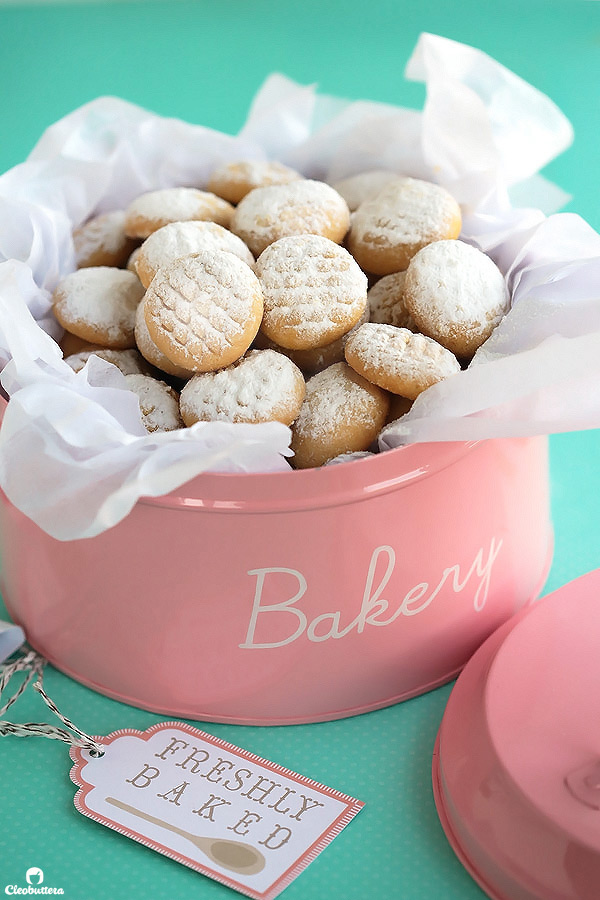
Aaaaaaand that’s a wrap!
Ramadan’s Middle Eastern Dessert palooza has come to an end and we’re sealing it with Eid Cookies! So roll up your sleeves people because we’re about to get covered in powdered sugar!

Let’s back up a little for those of you who’re lost here.
Eid (in this case Eid Al Fitr) is the feast holiday that marks the end of Ramadan. Because after a month-long of fasting, you bet we’re going to be feasting.
Eid El-Fitr celebrations last for 3 days, and it’s a time where people exchange gifts, wear new clothes (aka the best excuse to go shopping?) and gather for… you guessed it…a feast.
And no Egyptian feast is complete without Kahk. The lightly spiced crumbly cookie stuffed with sweet surprises and buried under copious amounts of powdered sugar.

Other than the return of my beloved cup of morning coffee, there’s nothing I associate the arrival of Eid more than the arrival of these cookies at my house.
Families and friends have been gifting each other with homemade and store-bought kahk since forever. So as you could imagine, the calories consumed during the three days of Eid make up for all those lost during the month’s fast.
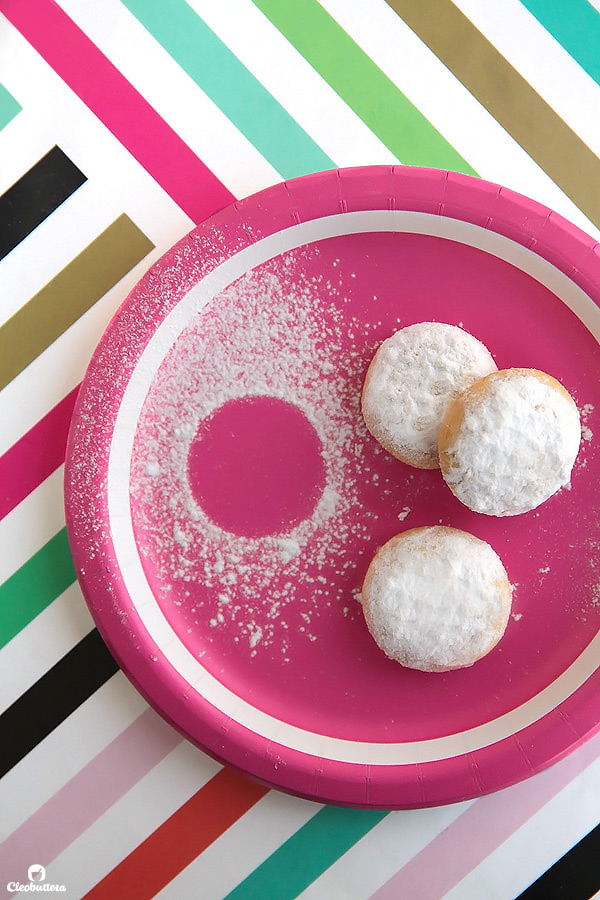
Kahk is believed to date back in Egypt to the 10th century, when palace kitchens made special cookies stuffed with gold coins and distributed them to the poor. Things have gone downhill ever since and we’ve been getting nuts and gooey honey filling instead of gold coins, but whatever…they’re still great!
But as much as they are delicious, Kahk is more about the essence of the celebration than about anything else. It is more of an event; an informal ritual that Egyptian families look forward to, than just a mere cookie that we love to gobble up. The process of making them is rarely a one-man show, but a chance for families to gather around baking trays and share stories and laughs over the hours of preparation.
Kids take part in putting their artistic touches by stamping their designs and filling the cookies, while grownups take over the baking part.

Ofcourse, every household has its own unique recipe that they treasure, but the basics remain the same. Kahk is a type of buttery sugar cookie with a sandy texture and mildly aromatic flavor. The cookies themselves are barely sweet, making way for more sweetness in the form of fillings and powdered sugar coating. In term of looks, they are comparable to Mexican Wedding Cookies and Snowballs. I have a feeling, the texture is similar too. Gotta try them to be sure:)

Kahk have these signature prints on top that are plain fun to make with special stampers, but also acts as a label to the different types of fillings. They also help the powdered sugar adhere to the surface.
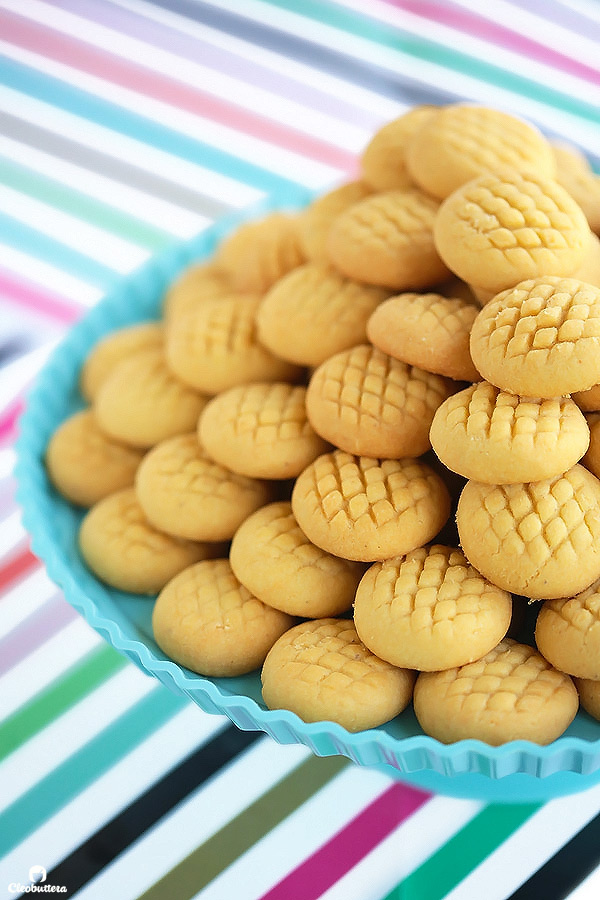
Kahk can have so many different fillings or can be left plain. Ofcourse it doesn’t come as a surprise that the kiddos will only have them plain or they’re not eating any.
The most popular filling by far is the Agameya (my favorite!). It’s a cooked mixture of ghee, honey, sesame seeds and optional nuts; most often walnuts. It’s sweet and gooey and irresistible. Kahk can also be stuffed with Turkish delight (malban), sticky sweet date paste (agwa) or plain nuts like walnuts and pistachios.
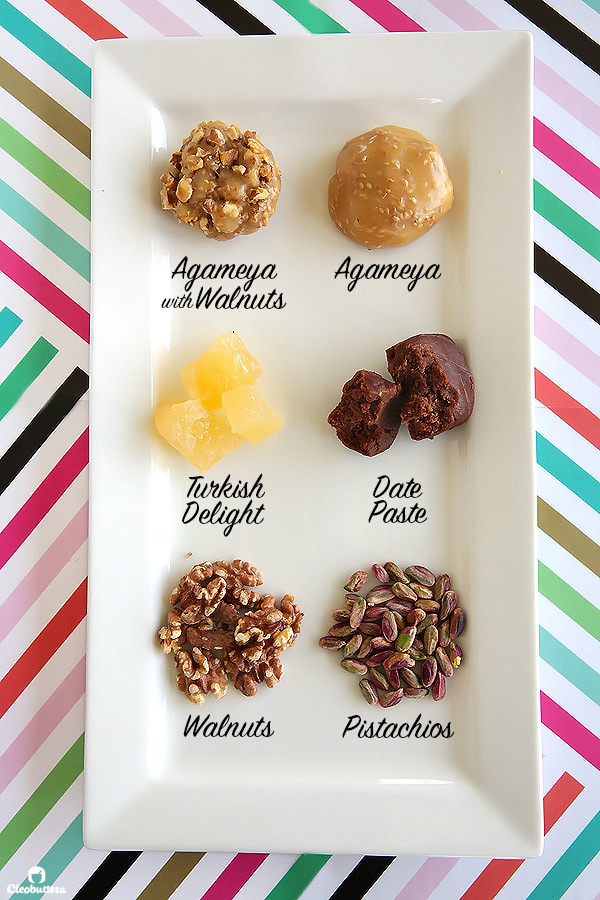
Though made from very simple ingredients, Agameya can be a little tricky to make. If its runny, it will ooze out of the cookies as they bake, and if its too hard, it will stick to your teeth and ruin your kahk experience. Trust me, I’ve had my fair share of both extremes, but I was finally able to settle on the right ratio of ingredients, paired with the perfect cooking period to produce a Agameya that is perfectly malleable and oh-so-delcious.

Now before we begin making our cookies, its a good idea to get all our fillings portioned and ready to go.

No wait… before we get elbow deep into making them, I need to tell you about this recipe in particular. I don’t mean to brag, but it makes the best kahk I’ve ever tasted. It is THE recipe you want in your life!
Believe it or not, I was never into kahk in the first place until last year. I mean they’ve always tasted ok to me, but they were never something I’d crave or would waste calories on. I’ve always had some reservations about their coarse texture and lack of sweetness in the cookie itself. I just enjoyed their presence and the joy they brought , but never the eating part. Until my sister-in-law got me a box of Kahk from Le Carnaval; one of Cairo’s finest high-end patisseries. One bite of their melt-in-the-mouth cookies was able to change my mind about Kahk. They were all of a sudden…cravable. I quickly became so consumed with finding a recipe that measured up to Le Carnaval’s. And with the guidance of a pastry chef friend…I finally did! Yes, it took an entire year, but it was worth it.
Before we dive into details, here’s a quick glimpse of how they come together to give you an idea.
The lightly aromatic flavor of this kahk is on point and part of it comes from the use of Kahk Essence (Reehet El Kahk). It is a special blend of spices, specifically made for Kahk, which gives it its distinctive flavor. If you can get your hands on some, awesome! If you can’t, you can always leave it out and still have great kahk, or you could refer to the substitutions in the ‘Notes’ section of the recipe at the end of the post.
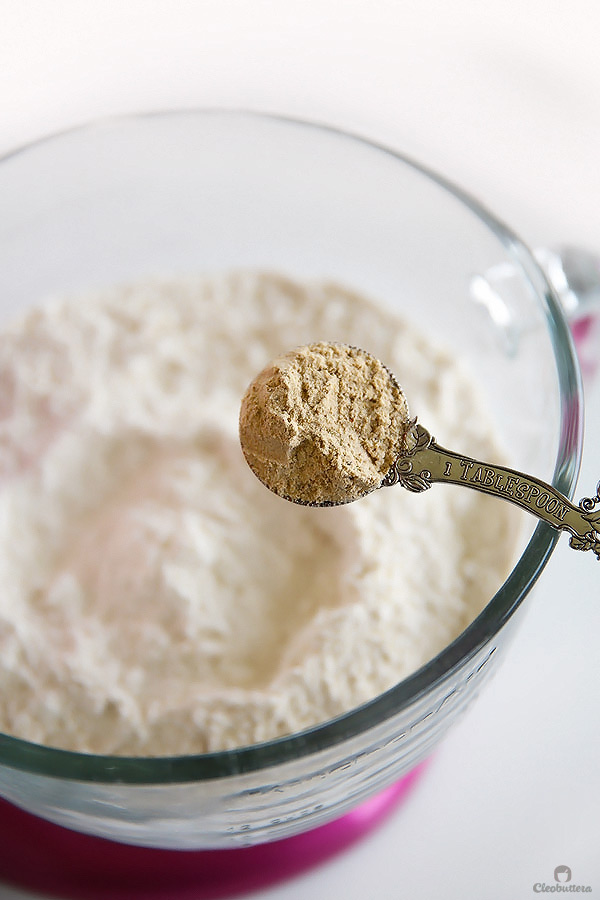
The other ingredient that either makes or breaks the flavor of these cookies, is ghee! Since A LOT goes into the dough, the flavor really comes through, so be sure to use the best quality you could find. Here’s how you could make your own.
I don’t get why Kahk has a reputation for being difficult to make. I mean… dry ingredients just get whisked together, then we dump in the ghee, mix until it becomes creamy and a smooth paste forms…

Then add in some milk. Mix in a little bit more until a cohesive dough forms. And that’s it! Dough done.

Here comes my beloved mini ice cream scoop again. My number 1 kitchen gadget! Perfect for portioning the cookies so they’re all the same size.
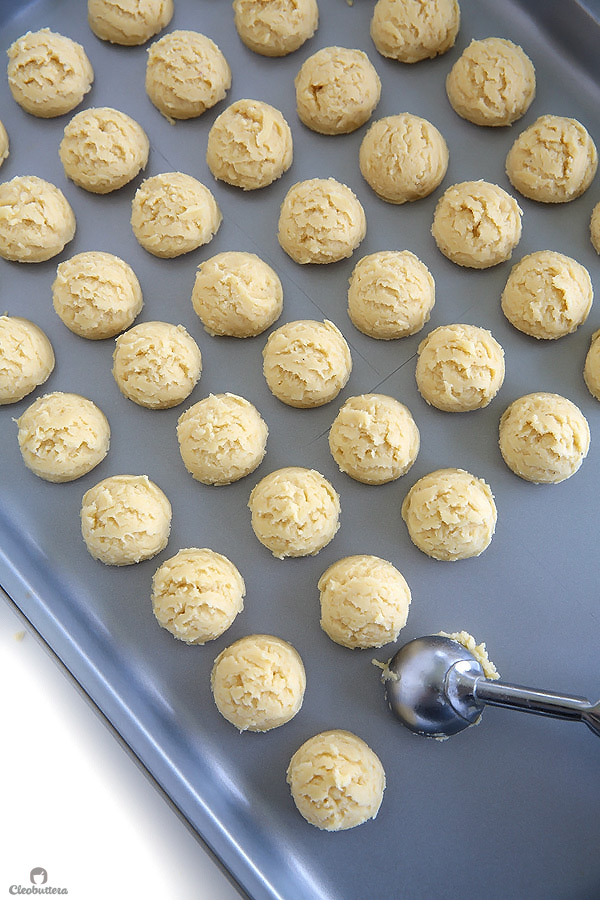
Then to fill, you’re going to roll the dough into a ball, make an indentation using your thumb, stuff with your filling of choice, reroll to cover the filling then stamp.
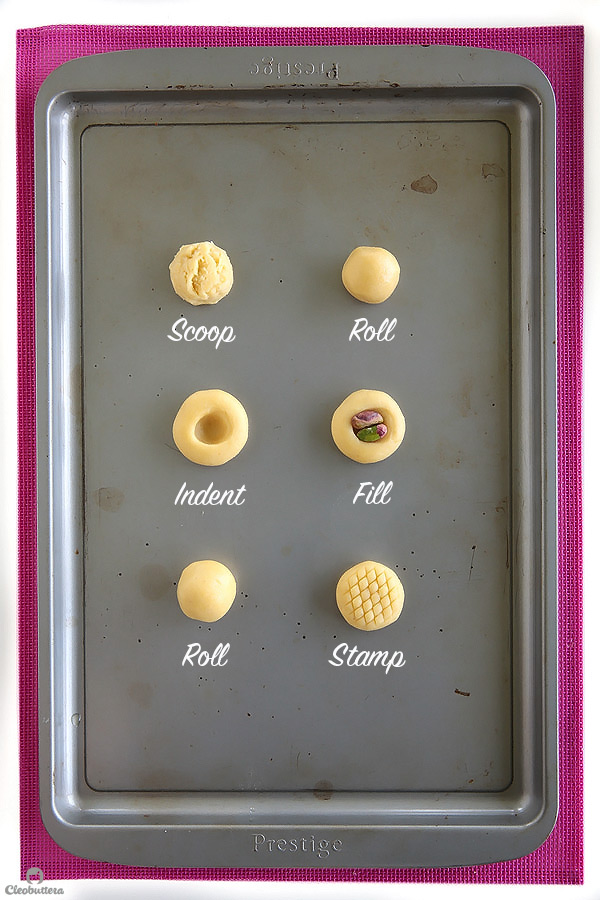
Kids LOVE doing this part, so get them involved! Stamp, stamp, stamp using the special kahk stamper or any stamper really.

These tweezer thingies are also traditional, but no worries if you can’t find it…

Because there’s always the fork. A la peanut butter cookie style.
In fact, you could skip the stamping all together if you want. They are a tradition more than anything else really. I actually recommend not stamping the agameya filled ones, as to not pierce the dough, which could let agameya ooze out. You can lightly press on them though with your hand or into a maamoul mold.

Now you’re gonna bake the cookies at 160C/ 320F for 18 to 22 minutes until firm to the touch, blonde on top and the bottom are golden brown.
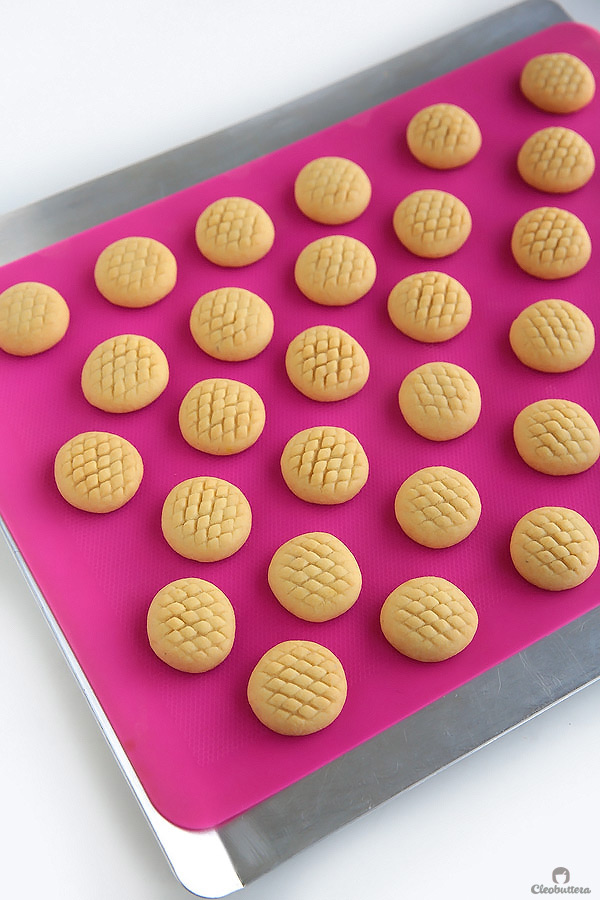
Allow the cookies to cool COMPLETELY, then let it snow!

Wrap up some and give to your neighbor and enjoy the rest.
You know you’re eating them wrong if you don’t get powdered sugar all over your face and shirt right?
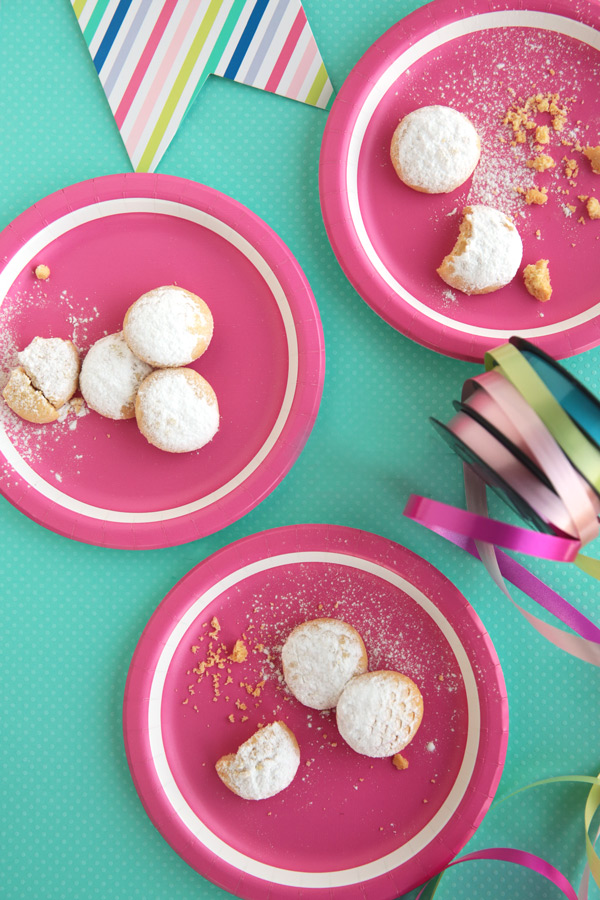
That’s all folks! I hope you’ve enjoyed this Kahk 101 crash course, as well as the month-long virtual Ramadan experience in Egypt and all the Middle Eastern food that came with it.
Wishing you a wonderful holiday and great summer break for everyone!
And now off to a much needed vacation, but will be back before you know it with more delicious treats from all over the world.
See ya!
Fabulous Kahk (Eid Cookies)

Please note that the recipe below is an updated, new and improved version of the original recipe. I've added a few tweaks that made a world of a difference. The old recipe can still be found in the 'Recipe Notes' below, in case you prefer to stick to it.
Ingredients
For the Kahk:
- 1 kg (8 cups) all purpose flour
- 65g (1/2 cup plus 1 tablespoon) powdered sugar, plus extra for coating
- 1/4 cup (40g) toasted sesame seeds (optional, but highly recommend)
- 1 1/2 teaspoons (6g) baking powder
- 1 teaspoon instant yeast (optional)*
- 1/8 teaspoon salt
- 1 tablespoon (10g) Kahk Essence (Reehet El Kahk)*
- One 1g packet vanilla powder (or 1/4 teaspoon vanilla extract)*
- 600g (2 1/2 cups plus 2 tablespoons) ghee or clarified butter, at room temperature*
- 160g (2/3 cup) milk, at room temperature
Filling Options:
- Leave them plain
- Agameya (honey filling) (recipe below)
- Malban (Turkish delight) (recipe below)
- Agwa (Date paste) (recipe below)
- Toasted walnuts, about 250g, chopped into large chunks
- Toasted Pistachios, about 250g
For the Agameya (Honey Filling): (Enough to fill about 50 kahks)
- 2 tablespoons (25g) ghee or clarified butter
- 1/4 cup (32g) all-purpose flour
- 3/4 cup (250g) honey
- 1 1/2 tablespoon (15g) toasted sesame seeds
- 1/4 teaspoon Kahk Essence (Reehet El Kahk) (optional)
- 1/4 cup (28g) finely chopped walnuts or favorite nut (optional)
For the Malban: (Enough to fill about 72 Kahks)
- 500g plain Turkish Delight (malban sada)
- 1 tablespoon (12g) ghee or clarified butter
- 2 tablespoons (20g) toasted sesame seeds
- 1/4 teaspoon Kahk Essence (Reehet El Kahk) (optional)
- 2/3 cup (75g) finely chopped walnuts or favorite nut (optional)
For the Agwa: (Enough to fill about 72 Kahks)
- 500g soft, high quality date paste (agwa)*
- 1 tablespoon (12g) ghee clarified butter, or more
- 2 tablespoons (20g) toasted sesame seeds (optional)
- 1/4 teaspoon Kahk Essence (Reehet El Kahk) (optional)
Instructions
To make the Kahk dough:
- Begin by cooking the Agameya, if using, as it needs to cool down completely before using (recipe below). Mix the Malban and Agwa fillings as per recipe below. Prepare all your fillings by rolling them into macadamia nut-sized balls. Arrange over parchment lined baking sheets and keep refridgerated until ready to use. Keep the plain nuts nearby.
- Adjust oven rack to middle position and preheat the oven to 160C/ 320F.
- In the bowl of a stand mixer fitted with a paddle attachment (or in a large bowl and using an electric handmixer, whisk together the flour, powdered sugar, sesame seeds (if using), baking powder, instant yeast (if using), salt, kahk essence and vanilla powder until well combined.
- Add the ghee (or clarified butter) and mix on medium-low speed until well blended and the dry ingredients are evenly coated. Raise speed to medium, and continue mixing until the dough turns creamy and paste-like; 1 to 2 minutes.
- With the mixer running on low speed, gradually pour in the milk. Continue mixing until a cohesive dough comes together. Do not over mix. To test if the dough is mixed enough, roll an apricot-size piece of dough between your hands, then gently press on it. The dough shouldn't crack. If it cracks, knead the dough for a few more seconds, then repeat the test.
- Using a measuring tablespoon or a tablespoon-sized ice cream scoop with a release mechanism, scoop out tablespoons of dough and place on a baking sheet. You should have approximately 135 dough scoops.
- Roll each dough into a ball, then (if filling) press the center with your thumb to make an indentation for the filling to sit in. Add in the filling of your choice, then gather the dough up over the filling to completely cover it. Make sure that no filling is peaking out. Roll the filled dough into a smooth ball without any cracks.
- Arrange the dough balls onto a silicon mat or parchment paper lined baking sheet, leaving an inch of space between each one.
- For fun and to be able to distinguish between the different kahk fillings, give them some designs. Press lightly on the dough with a kahk stamper (khattama) or decorate with kahk shaping tweezers (mona'ash), if available. If not, make a cross hatch design using the twines of a fork, or simply press down with your hand and leave plain. DO NOT stamp agameya-filled dough, because this could tear the dough causing the agameya to ooze out while baking. Instead, just lightly press down on them, or press gently into a maamoul mold. Similarly, be very gentle with decorating the malban-filled kahk and be careful not to pierce the dough.
- Bake until blonde on top and the bottom takes on a light golden brown color; about 18 to 22 minutes. Be careful not to overbake the ones with the agameya and malban, as that could harden the fillings.
- Cool for a few minutes on the baking sheet, then transfer to a wire rack to cool COMPLETELY before dusting with powdered sugar, otherwise the sugar will melt on the kahk and make a wet surface.
- Using a small sieve, dust the kahk with a generous amount of powdered sugar or roll into a bowl full of sugar.
- Serve or store in a container. Kahk will keep well at room temperature for weeks and weeks.
To make the Agameya (honey filling):
- In a small saucepan over medium-high heat, melt the ghee (or clarified butter). Add flour and cook, stirring constantly with a small whisk or rubber spatula, until the mixture turns golden blonde in color.
- Add the honey and bring to a boil, stirring constantly. Once boiled, cook a little longer until barely thickened and has the consistency of hot caramel sauce; about 1 minute longer. The best way to get the perfect consistency everytime, is to use a candy or an instant-read thermometer. It should measure 118C/245F which is the soft-ball stage. If you don't have a thermometer, drop a little bit of the mixture in ice-cold water and wait for about 30 seconds to cool down the mixture. When touched with your finger, it should hold its shape, but remain soft and malleable; it should not stick to the teeth. (Do not overcook, or it will harden).
- Remove saucepan from the heat and stir in the sesame seeds, kahk essence and nuts, if using.
- Transfer agameya to a small bowl and refrigerate until firm but soft enough that you can shape it.
- Using greased hands, roll into small macadamia nut-sized balls. Arrange over parchment lined baking sheets and keep refridgerated until ready to use.
To make the Malban:
- Knead the Turkish Delight (Malban) with the ghee, sesame seeds and kahk essence, if using until soft and pliable. Knead in the walnuts, if desired.
- Using greased hands, roll into small macadamia nut-sized balls. Arrange over parchment lined baking sheets and keep refridgerated until ready to use.
To make the Agwa:
- Knead the Agwa (date paste) with the ghee, sesame seeds and kahk essence, if using until soft and pliable. If you're starting with a stiff date paste, add more ghee as needed, until the agwa is nice and maleable.
- Using greased hands, roll into small macadamia nut-sized balls. Arrange over parchment lined baking sheets and keep refridgerated until ready to use.
Recipe Notes
- Please note that the recipe above is an updated, new and improved version of the original recipe. I've added a few tweaks that made a world of a difference. The changes make for a kahk that is smoother, finer in texture, more flavorful and prevents the fillings from bursting out or hardening. I've slightly reduced the sugar, as less sugar equals finer crumb when it comes to kahk. The lower sugar content also better accomodates for the sweet fillings and the mountain of powdered sugar that covers it. Feel free to adjust the sweetness according to your preference, going no lower than 50g and not higher than 100g. I've also increased the sesame seeds for a nuttier flavor and added an optional teaspoon of yeast to capture that old fashioned Kahk flavor like that of our grandmothers. I've also reduced the baking temperature to 160C instead of 180C, as it results in a finer, more tender texture and prevents the agameya from bursting out or hardening. I've also completely changed the agameya recipe as the older was so tricky to work with.
- The old recipe was so loved, but I couldn't help to revisit it to make it even better, as well as address some of the issues some people were facing. If you've had great success with the old recipe and would still prefer to stick to it, please follow the following amounts instead of those above, but I'd still recommend baking at 160C instead of 180C, especially if you're filling it:
1 kg (8 cups) all purpose flour
100g (1 cup minus 1 tablespoon) powdered sugar, plus extra for coating
3 tablespoons toasted sesame seeds (optional)
1 1/2 teaspoons (6g) baking powder
1/8 teaspoon salt
1 tablespoon (10g) Kahk Essence (Reehet El Kahk)
1 packet vanilla sugar (or 1/2 teaspoon vanilla extract)
600g (2 1/2 cups plus 2 tablespoons) ghee or clarified butter, at room temperature (*see note)
160g (2/3 cup) milk, at room temperature
- This recipe makes amazing mini sized kahk too! Each one is the size of a grape 😍 I love to either leave them plain or fill them with toasted walnut bits. I wouldn't recommend filling the minis with softer fillings such as agameya and malban, as they'll pose a challenge while stuffing. Leave them round; don't press them and bake at the same temperature for 10 to 12 minutes.
- My preferred brand of ghee is Best Sherraton brand. However, if you have samna balady (white ghee), you can use that instead, or a combination of both yellow ghee (such as Best Sherraton) and white balady ghee. All white balady ghee will be heavier in taste and stronger in ghee flavor.
- Butter cannot be used here unless you clarify first. Here's a great tutorial for making your own clarified butter (ghee), in case you don't have it where you live.
- For a longer shelf life, without the kahk changing its taste, heat the ghee until super hot, then transfer to a heat-proof bowl and refrigerate until its back to room temperature. Use cool or at room temperature. If using white samna balady, or clarified butter, no need for the heating step.
- The yeast is added for flavor purposes only; it does not lift or rise the dough, so no need to let the dough sit to proof. I recently added the yeast to capture that old-fashioned flavor from the olden days. It's a tiny amount, so it won't make the kahk taste like bread; it just adds another flavor dimension. You can omit it, if you prefer the modern tasting kahk, or you can increase it up to 1 tablespoon for a stronger taste.
- Kahk essence is a powdered mixture of spices that gives Kahk its distinctive flavor. It is a combination of ground mahlab, cardamom, bay leaves, rose rice, cloves and fennel. Though I haven't tried it myself, I heard that you can make it by mixing equal amounts of each. Otherwise, you could just leave it out and still have some pretty amazing kahk. In fact, some people actually prefer their kahk without it. You can also substitute an equal amount of rose water.
- Kahk essence is readily available in Egypt where I live at spice shops; I get mine from Ragab El Attar.
- The vanilla powder I use is Cook's brand.
- I get plain malban (Turkish Delight) and soft Saudi Arabian date paste from Darb El Barabra shop in Cairo.
- For the best possible results and maximum accuracy, it is highly recommended that you weigh all ingredients (including the milk) using a scale, instead of using measuring cups.
Measurements Note: All recipes of this site have been developed using weight measurements. Although US volume measurements have been included for your convenience, it is highly encouraged that you weigh your ingredients using a kitchen scale to get the best possible results. Due to the sensitive nature of baking, kitchen scales are proven to yield more accurate and consistent results than measuring cups. Enjoy!
This post may contain affiliate links.
All images and content are owned by Cleobuttera® and are copyright protected. Please do not use my images without prior permission. If you would like to republish a recipe, please rewrite it in your own words and link back to the recipe page on my site. Original recipes and creations of this site are intended for personal and home use. Commercial replication or media consumption are only allowed with a written consent and agreement with Cleobuttera owners. Otherwise it is considered a violation of intellectual property. Thank you for respecting and appreciating the amount of time and effort that goes into creating free, unique recipes that make people happy.